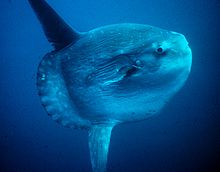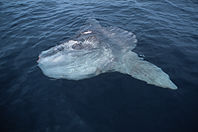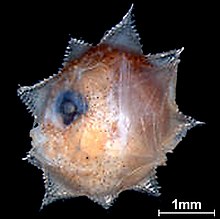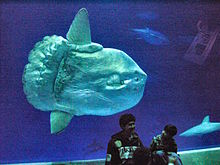| Revision as of 23:37, 5 July 2007 editMichael Devore (talk | contribs)Extended confirmed users, Pending changes reviewers, Rollbackers36,199 editsm typo← Previous edit | Revision as of 05:20, 6 July 2007 edit undo74.194.0.193 (talk) →Naming and TaxonomyNext edit → | ||
| Line 28: | Line 28: | ||
| ==Naming and Taxonomy== | ==Naming and Taxonomy== | ||
| Many of the sunfish's various names allude to its unique flattened shape. Its specific name, ''mola'', is Latin for "millstone", which the fish resembles because of its grey color, rough texture, and rounded body. Its common English name, sunfish, refers to the animals habit of "sunbathing" at the surface of the water. The French- and Spanish-language names, ''poisson lune'' and ''pez luna'', both mean "moon fish", in reference to its rounded shape. In German, the fish is known as ''Schwimmender kopf'', or "swimming head", because it has no true tail. The Taiwanese refer to it as the "toppled car fish" for its tendency to lay on |
Many of the sunfish's various names allude to its unique flattened shape. Its specific name, ''mola'', is Latin for "millstone", which the fish resembles because of its grey color, rough texture, and rounded body. Its common English name, sunfish, refers to the animals habit of "sunbathing" at the surface of the water. The French- and Spanish-language names, ''poisson lune'' and ''pez luna'', both mean "moon fish", in reference to its rounded shape. In German, the fish is known as ''Schwimmender kopf'', or "swimming head", because it has no true tail. The Taiwanese refer to it as the "toppled car fish" for its tendency to lay on its side while sunbathing. | ||
| The ocean sunfish has various obsolete ] synonyms, and was originally classified in a pufferfish genus, as ''] mola''.<ref name=CatalogOfFishes">{{FishBase_genus | The ocean sunfish has various obsolete ] synonyms, and was originally classified in a pufferfish genus, as ''] mola''.<ref name=CatalogOfFishes">{{FishBase_genus | ||
Revision as of 05:20, 6 July 2007
- This article is about the ocean sunfish, Mola mola. For other fishes known as "sunfish", see sunfish.
| Ocean sunfish | |
|---|---|

| |
| Scientific classification | |
| Kingdom: | Animalia |
| Phylum: | Chordata |
| Class: | Actinopterygii |
| Order: | Tetraodontiformes |
| Family: | Molidae |
| Genus: | Mola |
| Species: | M. mola |
| Binomial name | |
| Mola mola (Linnaeus, 1758) | |
The ocean sunfish (Mola mola) or common mola is the heaviest bony fish in the world, with an average weight of 1000 kilograms. The species is native to tropical and temperate waters around the globe. It resembles a fish head without a tail, and its main body is flattened laterally. Sunfish can be as tall as they are long, when their dorsal and anal fins are extended.
Sunfish live on a diet that consists mainly of jellyfish. As this diet is nutritionally poor, they consume large amounts in order to develop and maintain their great bulk. Females of the species can produce more eggs than any other known vertebrate. Sunfish fry resemble miniature pufferfish, with large pectoral fins, a tail fin and body spines uncharacteristic of adult sunfish.
Adult sunfish are vulnerable to few natural predators, but sea lions and Killer Whales, Orcinus orca, will consume them. Among humans, sunfish are considered a delicacy in some parts of the world, including Japan and Taiwan, but sale of their flesh is banned in the European Union. Sunfish are frequently, though accidentally, caught in gillnets, and are also vulnerable to harm or death from encounters with floating trash, such as plastic bags.
A member of the order Tetraodontiformes which includes pufferfish, porcupinefish and filefish, the sunfish shares many traits common to members of this order. Sunfish was originally classified as Tetraodon mola. under the pufferfish genus. But it has since been given its own genus, Mola, with two species under it. The ocean sunfish, Mola mola is the type species of the genus.
Naming and Taxonomy
Many of the sunfish's various names allude to its unique flattened shape. Its specific name, mola, is Latin for "millstone", which the fish resembles because of its grey color, rough texture, and rounded body. Its common English name, sunfish, refers to the animals habit of "sunbathing" at the surface of the water. The French- and Spanish-language names, poisson lune and pez luna, both mean "moon fish", in reference to its rounded shape. In German, the fish is known as Schwimmender kopf, or "swimming head", because it has no true tail. The Taiwanese refer to it as the "toppled car fish" for its tendency to lay on its side while sunbathing.
The ocean sunfish has various obsolete binomial synonyms, and was originally classified in a pufferfish genus, as Tetraodon mola. It is now placed under its own genus, Mola, with two species under it: Mola mola and Mola ramsayi. The ocean sunfish, Mola mola is the type species of the genus.
The Mola genus belongs to the Molidae family. This family comprise 3 generas: Masturus, Mola and Ranzania. The common name "sunfish" without qualifier is used to describe the Molidae marine family as well as the freshwater sunfishes in the family Centrarchidae which are unrelated to Molidae. On the other hand, the name "ocean sunfish" and "mola" refer only to the family Molidae.
The Molidae family belongs to the order Tetraodontiformes which includes pufferfish, porcupinefish and filefish. Sunfish shares many traits common to member of this order, including the four fused teeth that form the characteristic beak and gives the order its name (tetra=four, odous=tooth and forma=shape). Indeed, sunfish larvae resemble spiky pufferfish more than they resemble adult molas.
Description

The ocean sunfish resembles a fish head without a tail. Its caudal fin is replaced by a rounded clavus, creating the body's distinct shape. The main body is flattened laterally, giving it a long oval shape when seen head-on. The pectoral fins are small and fan-shaped. However, the dorsal fin and the anal fin are lengthened, often making the fish as tall as it is long. Specimens up to 3.2 metres (10.5 ft) in height have been recorded.
The ocean sunfish has an average length of 1.8 metres (5.9 ft), and an average weight of 1,000 kilograms (2,200 lbs), although individuals up to 3.3 metres (10.8 ft) in length and weighing up to 2,300 kilograms (5,100 lbs) have been observed.
The spinal column of M. mola contains fewer vertebrae and is shorter in relation to the body than that of any other fish. The spinal cord of a specimen measuring 2.1 metres (7 ft). in length is under 25 millimetres (1 in) long. Even though sunfish descended from bony ancestors, its skeleton actually contains largely cartilage tissues which is lighter than true bone and allows it to grow to sizes uneconomical for other bony fishes.
The sunfish lacks a swim bladder. Some sources indicate that the internal organs contain a concentrated neurotoxin, tetrodotoxin, like the organs of other poisonous tetraodontiformes, while others dispute this claim.
Fins

In the course of its evolution, the caudal fin (tail) of the sunfish disappeared, to be replaced by a lumpy pseudo-tail, the clavus. This structure is formed by the convergence of the dorsal and anal fins. The smooth-denticled clavus retains twelve fin rays, and terminates in a number of rounded ossicles. Without a true tail to provide thrust for forward motion and equipped with only small pectoral fins, Mola mola relies on its long, thin dorsal and anal fins for propulsion, driving itself forward by moving these fins from side to side.
Ocean sunfish often swim near the surface, and their protruding dorsal fins are sometimes mistaken for those of sharks. However, it is possible to distinguish a shark from a sunfish, by observing the trajectory made by the dorsal fin on the surface, while the fish itself moves underwater and remains unseen. Sharks, like most fish, swim by waving the tail sideways while keeping the dorsal fin moving in a straight line. The sunfish, on the other hand, swings its dorsal fin and anal fin in its characteristic sculling motion. Thus, the sideways movement of the dorsal fin on the surface can be used to identify the sunfish.
Skin
Adult sunfish range from brown to silvery-gray or white, with a variety of mottled skin patterns; some of these patterns may be region-specific. Coloration is often darker on the dorsal surface, fading to a lighter shade ventrally as a form of camouflage. Mola mola also exhibits the ability to vary skin coloration from light to dark, especially when under attack. The skin is up to 3 inches (7.6 cm) thick in places, and is covered by denticles and a layer of mucus instead of scales. The skin on the clavus is smoother than that on the body which can be as rough as sandpaper.
More than 40 species of parasites may reside on the skin and internally, motivating the fish to seek relief in a number of ways. Drifting kelp fields harbor cleaner wrasses and other fish which remove parasites from the skin of visiting sunfish. By basking on its side at the surface, the sunfish also allows seabirds to feed on parasites from their skin. Sunfish have been reported to breach more than ten feet above surface, possibly as another effort to dislodge parasites on the body.
Range and behavior

Ocean sunfish are native to the temperate and tropical waters of every ocean in the world. Mola genotypes appear to vary widely between the Atlantic and Pacific, but genetic differences between individuals in the Northern and Southern Hemispheres are minimal.
Sunfish are pelagic and swim at depths of up to 591 metres (1,939.0 ft). Contrary to the general perception that sunfish spend much of their time basking at the surface, research suggests that adult M. mola actually spend a large portion of their lives submerged at depths greater than 200 metres (656.2 ft), occupying both the epipelagic and mesopelagic zones. They stay in water warmer than 10 °C (50 °F) most of times. In fact, prolonged periods spent in water at temperatures of 12° C (53 °F) or lower can lead to disorientation and eventual death. Researches theorize that the basking behavior at the surface may be a method of "thermally recharging" following dives into deeper, colder water. Others point to sightings of the fish in colder waters such as those southwest of England outside of its usual habitat as evidence of increasing marine temperatures.
Sunfish are usually found alone, but occasionally in pairs. They swim primarily in open waters, but are sometimes seen near kelp beds taking advantage of resident populations of smaller fish which remove ectoparasites from their skin. Because sunfish must consume a large volume of prey, their presence in a given area may be used as an indicator of nutrient-rich waters where endangered species may be found.
Feeding
The diet of the ocean sunfish consists primarily of various jellyfishes. But it also consumes salps, comb jellies, zooplankton, squid, crustaceans, small fishes, fish larvae, and eel grass. This diet is nutritionally poor, forcing the sunfish to consume large amount of food in order to maintain its size. The range of food items found inside sunfish indicates that the sunfish feeds at many levels, from the surface to deep water, and occasionally down to the seafloor in some areas.
Sunfish can spit out and pull in water through its small mouth to tear apart soft-bodied prey. Its teeth are fused into a beak-like structure, allowing it to break up harder organisms. In addition, pharyngeal teeth located in its throat grinds food into smaller pieces before passing them to the stomach.
Life cycle

Ocean sunfish may live up to ten years in captivity, but their lifespan in a natural habitat has not yet been determined. Their growth rate is also indeterminate. However, it is known that a young specimen at the Monterey Bay Aquarium increased in weight from 26 kg (57 lbs) to 399 kg (880 lbs) and reached a height of nearly 1.8 m (6 ft) in fifteen months.
The sheer size and thick skin of an adult of the species deters many smaller predators, but younger individuals are vulnerable to predation by bluefin tuna and mahi mahi. Adults are consumed by sea lions and orcas. Sea lions appear to hunt molas for sport, tearing the fins off, tossing the body around, and then simply abandoning the still-living but helpless fish to die on the seafloor.
The mating practices of the ocean sunfish are poorly understood, but spawning areas have been suggested in North Atlantic, South Atlantic, North Pacific, South Pacific, and Indian Oceans. Females can produce as many as 300 million eggs at a time, more than any other known vertebrate. Sunfish eggs are released into the water and externally fertilized by sperm.
Newly-hatched sunfish larvae are only one-tenth of an inch long. They grow to become fry, and those which survive grow many millions of times their original size before reaching adult proportions. Sunfish fry, with large pectoral fins, a tail fin and body spines uncharacteristic of adult sunfish, resemble miniature pufferfish, their close relatives in the evolutionary tree. Young sunfish school for protection, but this behavior is abandoned as they grow.
Human interaction
Despite their size, ocean sunfish are docile, and pose no threat to human divers. Areas where they are commonly found are popular destination for sport dives, and sunfish at some locations have reportedly become familiar with divers. In fact, the fish is more threatening to boaters than swimmers, as its immense size and weight can cause significant damage when impacted by watercraft. Collisions with sunfish may cause damage to the hull of a boat, and their bodies can become lodged in the propellers of larger ships.

The flesh of the ocean sunfish is considered a delicacy in some regions, the largest markets being Taiwan and Japan. All parts of the sunfish are used in cuisine, from the fins to the internal organs. Some parts of the fish are used in some areas of traditional medicine.
Sunfish are accidentally but frequently caught in drift gillnet fisheries, making up nearly 30% of the total catch of the swordfish fishery employing drift gillnet in California. The by-catch rate is even higher for the Mediterranean swordfish industry, with a 71% to 90% of total catch being sunfish.
The fishery, bycatch and destruction of ocean sunfish is unregulated worldwide. In some areas, the fish are "finned" by fishermen who regard them as worthless bait thieves. This process, in which the fins are cut off, results in the eventual death of the fish, because it can no longer propel itself without its dorsal and anal fins. The species is also threatened by floating trash such as plastic bags which resemble jellyfish, its main diet. Bags can choke and suffocate an individual or fill its stomach to the extent that it starves.
Many areas of sunfish biology remain poorly understood, and various research efforts are underway, including aerial surveys of mola populations, satellite surveillance using pop-off satellite tags, genetic analysis of tissue samples, and collection of amateur sighting data. Recent studies indicate a decrease in sunfish populations that may be caused by more frequent bycatch and the increasing popularity of sunfish in human diet.
Sunfish in captivity

Sunfish are not widely held in aquarium exhibits, due to the unique and demanding requirements of their care. Some Asian aquariums display them, particularly in Japan, to which the sunfish is native. The Kaiyukan Aquarium in Osaka, Japan is one of few aquariums with mola on display, where it is reportedly as popular an attraction as the larger whale sharks.
The first ocean sunfish to be held in an aquarium in the United States arrived at the Monterey Bay Aquarium in August of 1986. Because sunfish had not been kept in captivity on a large scale before, the staff at Monterey Bay were forced to innovate and create their own methods for capture, feeding, and parasite control. By 1998, these issues were overcome, and the aquarium was able to hold a specimen for more than a year, later releasing it after its weight increased by more than fourteen times. Mola mola have since become a permanent feature of the Outer Bay exhibit.
As the ocean sunfish is not highly maneuverable, preventing specimens from injuring themselves by rubbing against the walls of a tank is of major concern to aquarists. In a smaller tank, hanging a vinyl curtain has been used as a stopgap measure to convert a cuboid tank to a rounded shape and prevent the fish from scraping against the sides. A more effective solution is simply to provide enough room for the sunfish to swim in wide circles. The tank must also be sufficiently deep to accommodate the vertical height of the sunfish, which can be nearly as tall as it is long, and may reach a height of 3.2 metres (10.5 ft).
Feeding captive sunfish in a tank with other faster-moving, more aggressive fish can also present a challenge. Eventually, the fish can be taught to feed from the end of a pole or from human hands.
Notes and references
- Froese, Rainer; Pauly, Daniel (eds.). "Species in genus Mola". FishBase. June 2007 version.
- Bass, L. Anna (2005). "Evolutionary divergence among lineages of the ocean sunfish family, Molidae (Tetraodontiformes)" (PDF). Marine Biology. 148 (2): 405–414. ISSN 0025-3162. Retrieved 2007-06-26.
{{cite journal}}: Unknown parameter|coauthors=ignored (|author=suggested) (help); Unknown parameter|month=ignored (help) - ^ Thys, Tierney. "Molidae Descriptions and Life History". OceanSunfish.org. Retrieved 2007-05-08.
- Thys, Tierney. "Molidae information and research (Evolution)". OceanSunfish.org.
{{cite web}}: Text "access2007-06-26" ignored (help) - ^ Juliet Rowan (2006). "Tropical sunfish visitor as big as a car". The New Zealand Herald. Retrieved 2007-05-08.
{{cite web}}: Unknown parameter|month=ignored (help) - ^ Froese, Rainer; Pauly, Daniel (eds.). "Mola mola". FishBase. March 2006 version.
- ^ "Mola mola program - Life History". Large Pelagics Research Lab. Retrieved 2007-05-11.
- ^ "Online Field Guide - Ocean sunfish". Monterey Bay Aquarium. Retrieved 2007-05-11. Cite error: The named reference "OnlineFieldGuide" was defined multiple times with different content (see the help page).
- ^ Thys, Tierney. "Ongoing Research". OceanSunfish.org. Retrieved 2007-06-11.
- "Strange tail of the sunfish". The Natural History Museum. Retrieved 2007-05-11.
- Johnson, G. David (2005). "Leis' Conundrum: Homology of the Clavus of the Ocean Sunfishes. 2. Ontogeny of the Median Fins and Axial Skeleton of Ranzania laevis (Teleostei, Tetraodontiformes, Molidae)" (PDF (fee required)). Journal of Morphology. 266 (1): 11–21. ISSN 0362-2525. Retrieved 2007-06-11.
We thus conclude that the molid clavus is unequivocally formed by modified elements of the dorsal and anal fin and that the caudal fin is lost in molids.
{{cite journal}}: Unknown parameter|coauthors=ignored (|author=suggested) (help); Unknown parameter|month=ignored (help) - ^ M. McGrouther (2004). "Ocean Sunfish Stranding". Australian Museum Online. Retrieved 2007-05-11.
{{cite web}}: Unknown parameter|month=ignored (help) - ^ M. McGrouther (2007). "Ocean Sunfish, Mola mola". Australian Museum Online. Retrieved 2007-05-11.
{{cite web}}: Unknown parameter|month=ignored (help) - ^ "Mola (Sunfish)". National Geographic. Retrieved 2007-05-08.
- ^ Powell, David C. (2001) . "21. Pelagic Fishes". A Fascination for Fish: Adventures of an Underwater Pioneer. Berkeley: University of California Press, Monterey Bay Aquarium. pp. pp. 270-275. ISBN 0-520-22366-7. OCLC 44425533. Retrieved 2007-06-13.
{{cite book}}:|pages=has extra text (help); External link in|chapterurl=|chapterurl=ignored (|chapter-url=suggested) (help) - Thys, Tierney. "Molidae information and research". OceanSunfish.org.
{{cite web}}: Text "access2007-05-11" ignored (help) - ^ Thys, Tierney (2003-11-30). "Tracking Ocean Sunfish, Mola mola with Pop-Up Satellite Archival Tags in California Waters". OceanSunfish.org. Retrieved 2007-06-14.
{{cite web}}: Check date values in:|date=(help) - ^ "Mola mola program - Preliminary results". Large Pelagics Research Lab. 2006. Retrieved 2007-04-11.
{{cite web}}: Unknown parameter|month=ignored (help) - Mark Oliver and agencies (2006). "Warm Cornish waters attract new marine life". Guardian Unlimited. Retrieved 2007-05-08.
{{cite web}}: Unknown parameter|month=ignored (help) - ^ M. McGrouther (2006). "Larval Ocean Sunfish, Mola mola". Australian Museum Online. Retrieved 2007-05-11.
{{cite web}}: Unknown parameter|month=ignored (help) - Fishes of the Gulf of Maine. "The Ocean Sunfishes or Headfishes". Fishes of the Gulf of Maine. Retrieved 2007-06-30.
- ^ Tierney Thys (February). Swim with giant sunfish in the open ocean (.swf) (Professional conference). Monterey, California, United States: Technology Entertainment Design. Retrieved 2007-05-30.
{{cite AV media}}: Check date values in:|date=and|year=/|date=mismatch (help) - Lulham, Amanda (2006-12-23). "Giant sunfish alarm crews". The Daily Telegraph. Retrieved 2007-06-12.
{{cite news}}: Check date values in:|date=(help) - "Sunfish". Australian Museum Online. Retrieved 2007-06-12.
- Thys, Tierney. "Present Fishery/Conservation". Large Pelagics Lab. Retrieved 2007-06-13.
- ^ "Current Research". Large Pelagics Research Lab. Retrieved 2007-06-11.
- "Have you seen a Mola??". Large Pelagics Research Lab. Retrieved 2007-06-11.
- ^ "Main Creature in Kaiyukan". Osaka Kaiyukan Aquarium. Retrieved 2007-06-13.
- "Aquarium Timeline". Monterey Bay Aquarium. Retrieved 2007-06-11.
External links
Research and info
- FishBase reference
- Integrated Taxonomic Information System (ITIS) reference
- Australian Museum
- Large Pelagics Research Lab
- OceanSunfish.org
Images and videos
- Mike Johnson Natural History Photography
- Phillip Colla Photography/Oceanlight.com
- Water Worx Dive Center Bali
- Video lecture (16:53): Swim with giant sunfish in the open ocean - Tierney Thys, Ph.D